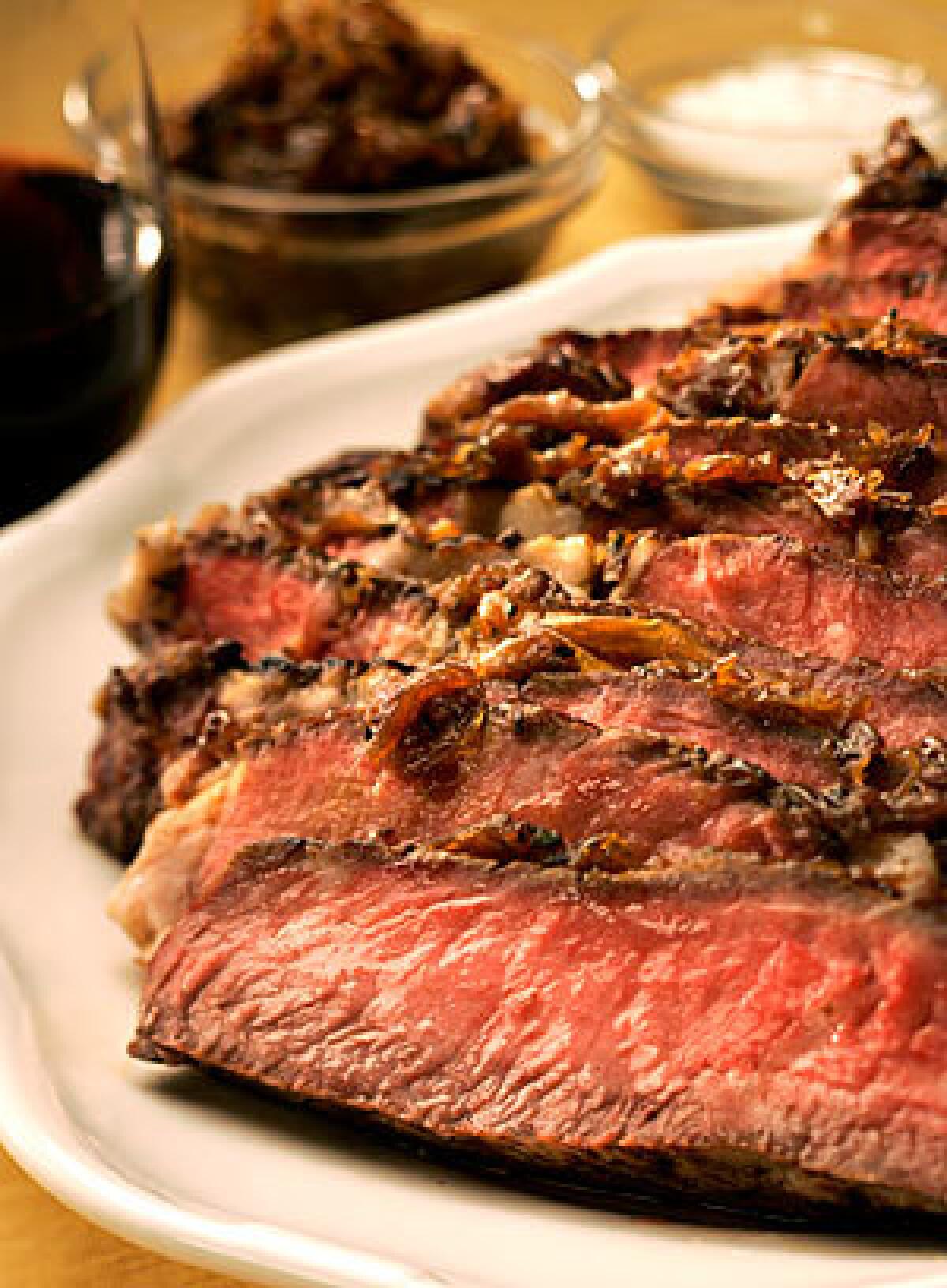Slow cook onions, and the results are delicious

- Share via
The daughter met me at the back door: “What is this stuff?” she asked. It was Monday night, our regular date for her to come over and wash her clothes and then eat dinner and watch “Dexter” with me (nothing like laundry and a TiVo-ed serial killer for father-daughter bonding).
She’d arrived early and, hungry, had dug around in the refrigerator for something to snack on. Finding a pot of my latest hobby, she’d smeared some on bread, topped it with a dab of goat cheese and popped it in her mouth.
“It’s like it fills your whole mouth with savory!” she said (I keep insisting she’s the real food writer in the family). “How do you make it?”
Well, I told her, you kinda just cook onions. “And then what? What do you add to it?” You just cook onions. That’s it.
Such is the miracle of long, slow cooking. The happy result of a marriage between 5 pounds of onions and four hours to kill, these onions caramelize to a deep, mahogany reddish-brown with a marmalade-like consistency.
There is sweetness, yes, but there is so much else, a powerful, mouth-filling deliciousness that can’t be described better than “savory.” And the texture is buttery enough that they can actually be used as a fat replacement.
There are so many things you can do with caramelized onions. There’s that simple snack my daughter made (toast the bread and you can call it crostini). My wife’s favorite pizza is topped with caramelized onions, goat cheese and black olives.
Or use it as a flavoring base. Stir it into a bowl of cooked grains such as buckwheat or farro, and just a little sautéed bitter greens becomes a great meal. Smear a bit onto a sandwich or a warm tortilla. It’s also terrific stirred into pasta sauces, stews or a pot of beans. Build a layer of it into a gratin and it will perfume the potatoes and make the texture seem richer without adding any fat. You can even serve it straight, dressed up with a little minced rosemary, as a sauce for meat.
Stuck at home last week with a head cold that made me unfit for work or company, I’d busied myself by making a big pot of caramelized onions. Other folks might kill sick days by watching soap operas or game shows, but for me, there’s nothing like a little mindless cooking.
Though I have to confess it’s almost a stretch to call this cooking. Preparing food doesn’t get much simpler. Here’s how it goes: Slice onions; put them in a pot with a little oil and some salt; cook and stir; cook and stir; cook and stir; cook and stir -- well, you get the picture.
Cooking caveats
But just because there are no long lists of ingredients or complicated techniques does not mean caramelizing onions is without pitfalls. The main one -- and it’s a dish-killer -- is that caramelizing can come awfully close to burning, and once you’ve scorched the onions there’s no way to get rid of that bitter flavor but to dump them out, wipe the pan clean and start over.
To avoid this, cook the onions in the heaviest pot you have over the lowest heat possible for much of the time, stirring as often as you can. That should be at least every 15 to 20 minutes for most of the cooking, shortening to 5 to 10 minutes when you get down to the end stages.
The pot should be really big, too. I usually use my nearly 7-quart enameled cast-iron Dutch oven to cook my onions and at the start it’s almost full to the top. But the onions wilt and shrink dramatically during cooking. Sprinkle them with a little salt to help draw out the moisture and just enough oil to keep them from sticking. Cover the pot and place it over medium-low heat.
After about 20 minutes you’ll find that the onions have started to soften and after about 45 minutes, they will be swimming in moisture -- it’s amazing just how much water an onion contains. At this point, you can increase the heat to medium and remove the lid to evaporate as much of that liquid as possible.
After about 75 minutes, the liquid will be very reduced and the onions will be the color of oatmeal. Here’s where it starts to get tricky, because there’s no longer enough moisture to keep the onions from scorching. You need to reduce the heat as low as it will go (use a flame tamer if necessary), and be vigilant about stirring every 10 to 15 minutes (I found this was a really good chore while I was ripping CDs onto my wife’s iPod).
When you reach the two-hour point, there will be almost no water left. The onions will have darkened a bit and will taste sweet, if slightly bland. Start stirring every five to 10 minutes.
At the three-hour point they’ll be getting really close. The color will have darkened substantially into a reddish-gold and the flavor will have become notably more complex (you’ll also find that your house will smell absolutely amazing).
When the onions have darkened just a bit further and you can hear them really sizzling despite the low heat, they’ll be done. They should still be moist and flexible, a bit like a shredded orange peel marmalade. Depending on just how low your flame will go, the full cooking will take from just over three hours to just under four.
That’s a lot of time, but not a lot of effort. And the good news is that caramelized onions are one of those things that are just as easy to make in large amounts as small. Once cooked, the onions can be used immediately or stored tightly covered in the refrigerator (there will be only a couple cups of them).
Though the word “caramelized” is associated with sweetness (it refers specifically to sugar browning, after all), you don’t want to do this with so-called “sweet onions” such as Vidalias or Mauis. That’s because those onions aren’t actually sweeter than regular onions.
That might sound weird, but it’s all part of the peculiar world of onion chemistry. The flavor of onions derives primarily from two factors -- the amount of sugar they contain and the amount of sulfuric “burn” they give you.
The so-called sweet onions actually just contain less of those sulfurous compounds than regular onions. This makes them taste sweeter when they’re raw and they are splendid sliced onto sandwiches or into salads.
But they also contain less sugar than regular onions, and because those acrid sulfurous compounds pretty much go away when heated, sweet onions turn bland as water after cooking.
The bottom line is, regular brown storage onions will make better caramelized onions than pricey sweet onions. You can use red onions if you like -- they have sufficient bite -- but the end result won’t be any better than with the brown ones, so why bother?
All those tears
It’s irresponsible to write about a recipe that calls for slicing 5 pounds of onions without addressing the question of “How do you keep from crying?”
I wish that I had some kind of miracle cure, but after 30 years of chopping onions, I don’t. Essentially, what makes you cry is those sulfuric compounds, and they’re created whenever the onion’s cell walls are broken.
There is no end to folkloric cures for this. Some people swear that holding a wooden spoon clenched between their teeth works. This isn’t as silly as it sounds, because squinting can reduce the amount of those gases that gets in your eyes. Goggles are said to work for the same reason. But there is dispute among onion chemists (yes, there are such people!) as to whether it is your eyes that react to the chemicals or the lining of your sinuses -- so if you want to try this technique, better make it a full-face mask.
I’ve tried the wooden spoon trick and not only did it not work for me, it made me feel even sillier than usual -- a big spoon in my mouth and tears running down my face. Your mileage may vary.
The only trick I’ve found that works isn’t really a trick -- keep your knives really sharp and it will minimize the amount of cell damage and reduce the amount of sulfuric compounds released. In essence, you’ll be slicing through a thin band of cells rather than crushing a wide one.
Other than that, the best thing is to do what I do when I’m standing there sobbing over a cutting board full of onions -- remember that tears are temporary, but the joy of having a jar of caramelized onions in the fridge lasts a long time.
More to Read
Sign up for The Wild
We’ll help you find the best places to hike, bike and run, as well as the perfect silent spots for meditation and yoga.
You may occasionally receive promotional content from the Los Angeles Times.








